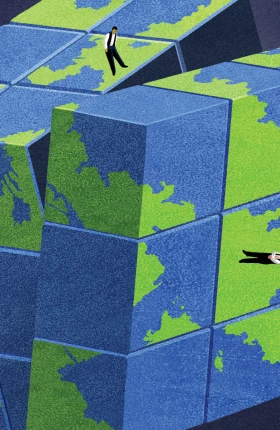Listening to the campaign promises of Donald Trump, the CEO of a global company may be forgiven if she believes that an emerging-market strategy can be put on pause right now. It would be perfectly reasonable to expect corporate tax cuts, reduced regulation, a fiscal stimulus on infrastructure, and increased tariffs on imports. Such a program will typically lead to higher interest rates in the US with a consequential capital outflow from emerging markets, as well as an adverse environment for exports to the US—a double whammy for emerging economies.
Is a pivot away from the emerging economies then in order? Let me argue as to why it is not.
If there is one thing that has become clear in the first 16 years of the 21st century, it is that a great reset in the global economic order is underway. This change has been led by China, but other countries have started to contribute to this shift. Despite the changing rhetoric about the performance of emerging economies after the fall in commodity prices and the slowdown in China, a simple statistic—the change in the share of GDP of populous emerging economies as a percentage of the G7 (US, Japan, Germany, France, UK, Italy, and Canada) economies—illustrates the trend. In 2000, the 17 most populous countries had a combined GDP that was only 20% of the G7 economies. The human statistic was pretty stark: 4.6 billion people lived in countries whose combined GDP was just 20% of the GDP of the 755 million people that lived in the G7. By 2016, the GDP share of these 17 countries as a percentage of the G7 countries went up to 63%. A tripling! Over the same period, three countries—China, India, and Indonesia—went from being 8.5% of G7 GDP to over 40% of G7 GDP. The speed of this reset is worthy of note and has serious implications for business. It is not equitable or fair that 67% of the world’s population has a combined GDP of just 63% of the G7, but nonetheless such a sharp reset provides major opportunities for business.
If we just stick to the almost three billion people who live in China, India, and Indonesia, their joint consumption will rise from $3.4 trillion to $14.5 trillion from 2010 to 2020. That equals US consumption. It is true that the per capita consumption in each of these countries is quite low, but it is rising, and in its wake is unlocking great aspiration and spending desire. This additional $11 trillion of consumption is spread among the rich, the emerging middle class, the young, the old, rural residents, urban dwellers, and in nuclear families (where women control consumption spending). This is very poorly understood or catered to. Smart CEOs need to emphasize the importance of understanding these consumers and how they wish to be served. CEOs can decide that they don’t want to play in this space, but they should do so consciously.
The other massive opportunity that arises is in the building of infrastructure in these countries. The gaps in infrastructure—in roads, ports, airports, power plants, railways, and urban centers—offer a $6 trillion opportunity. This is a huge but terribly difficult opportunity. It requires a deep understanding of the ecosystem within a country and, if not properly managed, can lead to large losses, litigation, and a loss of top management time. Infrastructure requires direct dealing with government. For the naive or uninitiated, it is fraught with great risk.
The emerging opportunity has spawned unlikely competitors. Many of the winners today are little known and rapidly growing companies from the emerging markets themselves. In 2014, The Boston Consulting Group had calculated that there were about 12,000 companies, globally, with revenues of over $1 billion. About 3,500 of these were in the US, another 3,500 in Asia, and about 5,000 in Europe. By 2020, China, India, and Indonesia will add another 3,000 such companies. These companies are aggressive, hungry, agile, and mostly family businesses. They can be competitors or partners, but they cannot be ignored on their home turf.
To win in this new environment in China, India, and Indonesia, I believe, we need to keep four big lessons in mind.
- First, do not play for this opportunity unless you can accept it on its own terms. View this new demand, this new consumer, as they are and not as you wish them to be. Do not believe these consumers will grow up and become American.
- Second, don’t waste time with a modest aspiration. These countries take CEO time. It is critical to get a good return on CEO time. So don’t play if it is not worthwhile. Not only will the organization waste time, but also no stakeholder—suppliers, dealers, partners, and, most importantly, good talent—will engage.
- The third truth is getting access to private information. Private information is critical for getting access to deals, information, or both on the shape of emerging regulations.
- Finally, while MNCs are good at handling investors, they do not always understand the state in emerging markets. Be it China, India, or Indonesia, if the company cannot engage with the state, especially in infrastructure, it cannot succeed. This is not the bad version but the good version of engagement—where players can interpret, inform, and influence the state honestly.
This big opportunity is coming about at the same time as the digital revolution, which is changing everything about the business landscape. The entire value chain, from production to distribution, is getting transformed. But the changes in technology should not minimize the gigantic global reset underway. Trump cannot stop it. Individual countries can move faster or slower, but business opportunities remain. The winners will have two things in common: they will go after the opportunity with serious intent, and they will do so on their own terms.
This commentary was originally published by The Indian Express on 12 January 2017.






